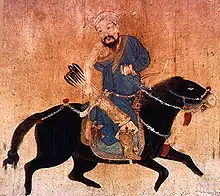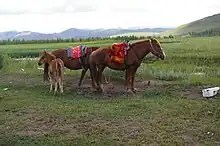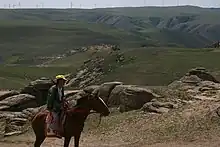Chinese Mongolian horse
The Chinese Mongolian (simplified Chinese: 蒙古马; traditional Chinese: 蒙古馬; pinyin: Ménggǔ mǎ) is a breed of horse, corresponding to the population of Mongolian horses that remained in China after Mongolia's independence in 1910. Possibly descended from Przewalski's horse, it has been domesticated since ancient times. In 1982, they accounted for a third of all horses in China. Since then, their numbers have declined sharply, under the influence of mechanized transport and modern lifestyles.
 Mare and foal in Inner Mongolia | |
| Country of origin | Inner Mongolia, China |
|---|---|
| Use | Saddle horse, mare milk, horse meat, and packhorse |
| Traits | |
| Weight |
|
| Height |
|
| Color | Bay, black, and gray |
This small, sturdy horse with great endurance comes in four types: Ujumqin, Abaga, Baicha and Wushen. The Chinese Mongolian is usually ridden or used a packhorse to transport local people. Mares produce milk, which is harvested and consumed as a traditional beverage. The breed is mainly represented in the Chinese province of Inner Mongolia, but is also found in small numbers in neighboring regions.
History

Although they share the same genetic origin, Mongolian horse populations are bred differently depending on whether they are located in Mongolia (Outer Mongolia) or China (Inner Mongolia), which justifies the distinction between the two breeds of Mongolian horse and Chinese Mongolian. Both are very ancient,[1] being recognized as among the oldest horse breeds in the world.[2] Bonnie Lou Hendricks estimates that this horse was domesticated on the Mongolian plateau 2 000 years BC,[3] but a mitochondrial DNA study suggests that horses have been domesticated in present-day northern China since earliest antiquity, 4 000 to 5 000 years BC.[2] The study attributes Przewalski's horse as its probable ancestor: "we can conclude that some Chinese Mongolian horses were closely related to, and perhaps descended from, Przewalskis". In any case, the Chinese Mongolian horse seems to be descended from multiple maternal lines and is genetically extremely close to the Mongolian horse.[4]
By the 7th century, the small Mongolian horse was present throughout the steppes of what is now northern China.[5] Out-breedings occurred as a result of diplomatic gifts from Central Asian kingdoms. At this time, the Mongolian horse was not in favor, as the Chinese imperial court preferred larger, racier animals from Persia (Iran) and Central Asia.[5] Under the Song dynasty, the Mongolian horse spread throughout China's three northern provinces,[2] to the point where the estimated population reached 40,000 head by the end of the Qing dynasty.[6]
The Mongolian horse made a clear cultural breakthrough in China after the Tang dynasty, from the 13th to the 16th century, as evidenced by paintings produced under the Yuan and Ming.[5] China then traded actively with Mongolia, with a large part of the China-Mongolia border dedicated to the horse and sheep trade. Mongolian herders traded their horses for silk, satin, cotton, needles and other such products.[7]
After the independence of Outer Mongolia in 1910, Mongolian horses from Inner Mongolia gradually spread to neighboring provinces, and experiments to "improve" the breed were carried out by the Chinese. However, these "improved" horses remained a distinct minority.[2] The theoretical separation of the Mongolian and Chinese Mongolian horse is a recent phenomenon dating back only a hundred years or so, explaining the close proximity between the two breeds.[4] The Chinese Mongolian has long been ubiquitous throughout the plains of Inner Mongolia, where it is raised in vast semi-wild herds, following the taboon system. The population was estimated at 1.7 million in 1982, representing a third of all Chinese horses.[8] By 2005, the number of horses had more than halved due to advances in motorization and the reduction in available grazing areas. Since then, the breed's decline and associated traditions have continued.[9]
Description

The model of the Chinese Mongolian is the same as that of the Mongolian horse. It is considered locally as a horse because of this model and not as a pony.[10] The head has a rectilinear profile[10] and is rather heavy, with a broad forehead, open nostrils, protruding eyes, and long ears.[11] The neck is short and muscular, the chest deep, the shoulder fairly sloping and muscular. The withers are not very prominent; the back is short, solid, and straight. The croup is long and sloping.[10] The legs are short, strong, and solid.[9] The breed is renowned for its solid constitution.[11] The average height is 1.28 m, 1.27 m for mares, and 1.30 m for males.[8] Weight ranges from 300 to 360 kg, with an average of 360 for males and 300 for females.[8] There are variations according to type.[12] For example, the University of Oklahoma study, dating from 2007, gives a size range from 1.21 to 1.42 m,[1] and CAB International, in its study published in 2016, 1.22 to 1.42 m.[9] Size increases markedly when environmental conditions are favorable.[10]
Coats
A wide range of coats are available, bay, black, chestnut, and gray being the most common, with a few rare cases of white horses.[8][10] It seems that all coat colors can be encountered.[9]
Temperament and care
The breeding method is semi-wild, with the young horse quickly trained to respond to a rider's commands. Although described as temperamental by some authors, the breed is reputed locally to be of good temperament, being ridden by children in particular. Chinese Mongols have excellent stamina.[3] It can cover 120 km in less than 8 hours and 28 to 30 km in 35 to 40 minutes.[9] The breed is adapted to wide temperature ranges,[10] from -50 to 35°C.[8] In winter, these horses dig through up to 40 cm of snow to find food.[9] They are raised extensively, without free access to water, in nomadic or transhumant systems.[8]

Types
There are four known types of Chinese Mongolian horse: the Abaga, the Baicha, the Ujumqin, and the Wushen.[9] The Baicha is a small, sturdy mountain horse on the verge of extinction, originally from central-western Inner Mongolia. It was once known as the "iron-hoofed horse", thanks to its sure-footedness in all types of terrain.[13] Among these types, the most genetically related are the Ujumqin and the Wushen,[10] which is surprising given the great geographical distance between the two breeding areas. This genetic proximity is likely the result of exchanges of breeding stock between breeders.[14]
Abaga
The Abaga (simplified Chinese: 阿巴加马; traditional Chinese: 阿巴加馬; pinyin: Abaga) averages 1.36 m to 1.40 m in height, and is predominantly black, more rarely dark bay.[15] It comes from the Abag Banner in the Xilingol League.[13][15] The Delachaux guide (2014) refers to this breed under the erroneous name of "Agaba".[15] The CAB International book, which is more reliable overall, does refer to the breed as "Abaga",[16] as do scientific publications on the subject.[17]
Ujumqin
The Ujumqin type (simplified Chinese: 乌珠穆沁马; traditional Chinese: 烏珠穆沁馬; pinyin: Wū zhū mù qìn mǎ, also named "Wuchumutsin"[18] and "Wuzhumuqin"[10]), is found in the Xilingol League region of eastern Inner Mongolia. Considered more elegant, it reaches a higher height.[10][12][13][18] Better conformed thanks to the quality of the grass in its native territory,[13] it is mainly used as a saddle horse.[8] An "improved" version of the Mongolian horse, it features the steppe horse type[10] and a light model. It has a remarkable aptitude for work.[18]
Wushen
The Wushen type is relatively small, averaging 1.22 m in height.[12] There are around 18,000 of these horses in the western and central steppes of Inner Mongolia,[10] particularly in the Otog Banner around Ordos.[14] Its distinctive features include extra gaits and a dry model.[13]
Genetic analysis
The average nucleotide mutation rate in the D loop of mitochondrial DNA in four Chinese Mongolian horses studied was 3.69 %. In Thoroughbreds, it is 4 %.[19]
Usage

This horse is mainly used for riding and mare milk production in Inner Mongolia: mares are milked five times a day.[10] Record milk production per lactation can exceed 300-400 kg.[9] The meat from these horses can be eaten, representing a vital product for the nomadic population.[10] In other provinces, the Chinese Mongolian can be used as a packhorse.[12] It is reputed to be excellent under saddle, capable of carrying heavy loads while finding its own food.[9]
Chinese Mongols are also used in crossbreeding to produce "improved" breeds, notably the Sanhe. The Sanhe,[20] however, is genetically quite distant from its ancestor.[14]
Breeding spread

Between 50,000 and 86,700 of these horses were listed by the FAO in 2005. Although the breed is in no way endangered, it is monitored.[8]
The Chinese Mongolian is found mainly in Inner Mongolia, but also in various regions of northern China, such as western Heilongjiang,[3] Gansu, Xinjiang and Qinghai.[8]
In culture
The Chinese Mongolian horse is present in modern Chinese literature, notably in Chinese-language poems that draw on Mongolian ethnic traditions, such as the 1993 poem Menggu ma by A'ertai.[21]
References
- Hendricks (2007, p. 126)
- Li et al. (2008, p. 1696)
- Hendricks (2007, p. 127)
- Li et al. (2008, p. 1701)
- Gernet, Jacques (1996). A History of Chinese Civilization. Cambridge University Press. p. 801. ISBN 0-521-49781-7.
- Mang, L. (2005). "Wuzhumuqin horse-outstanding species on Xilingoluo grasslands". China-Collection Industry. pp. 77–80.
- Twitchett, Denis; Mote, Frederick (1998). The Cambridge History of China. Vol. 8. Cambridge University Press. p. 241. ISBN 0-521-24333-5.
- "Mongolian/China". Domestic Animal Diversity Information System of the Food and Agriculture Organization of the United Nations. Retrieved 3 October 2015.
- Porter et al. (2016, p. 452)
- Hendricks (2007, p. 128)
- Puel (1989, p. 28)
- Puel (1989, p. 31)
- Porter et al. (2016, p. 453)
- Li et al. (2008, p. 1702)
- Rousseau (2014, p. 359)
- Porter et al. (2016, p. 432)
- Wang, Wei; Wang, Shenyuan; Hou, Chenglin; Xing, Yanping (2014). "Genome-Wide Detection of Copy Number Variations among Diverse Horse Breeds by Array CGH". PLOS ONE. 9 (1): e86860. Bibcode:2014PLoSO...986860W. doi:10.1371/journal.pone.0086860. ISSN 1932-6203. PMC 3907382. PMID 24497987.
- "Mongolian - Ujumqin/China". Domestic Animal Diversity Information System of the Food and Agriculture Organization of the United Nations. Retrieved 19 October 2015.
- Mang, L.; Li, J. L.; Shi, Y. F. (2005). "Sequence comparing of mtDNA D-Loop varied region in Chinese Mongolian horse and External Thoroughbred horse". Yi Chuan = Hereditas. 27 (1): 91–94. PMID 15730967.
- Hendricks (2007, p. 370)
- Zhang, Yingjin (2015). "Ethnic Mongolian Literature". A Companion to Modern Chinese Literature. John Wiley & Sons. p. 592. ISBN 978-1118451601.
Bibliography
- Hendricks, Bonnie (2007). "Chinese Mongolian". International Encyclopedia of Horse Breeds. University of Oklahoma Press. ISBN 978-0806138848.
- Li, Jinlian; Shi, Youfei; Fan, Caiyun; Manglai, Dugarjaviin (2008). mtDNA diversity and origin of Chinese Mongolian horses (PDF). Vol. 21. Asian-Aust. J. Anim. Sci.
- Mang, L. (2002). Mongolian man and horse. Inner Mongolia Science and Technology Press.
- Porter, Valerie; Alderson, Lawrence; Hall, Stephen; Sponenberg, Dan Phillip (2016). Mason's World Encyclopedia of Livestock Breeds and Breeding (6th ed.). CAB International. ISBN 978-1-84593-466-8.
- Puel, Caroline (1989). "Où sont donc passés les chevaux chinois ?". Le petit livre du cheval en Chine, Favre. Caracole (in French). ISBN 978-2828903312.
- Rousseau, Élise (2014). Tous les chevaux du monde (in French). Delachaux et Niestlé. ISBN 978-2-603-01865-1.
- Zheng, Piliu (1984). "Horses". Livestock Breeds of China. Food and Agriculture Organization. ISBN 9251021856.